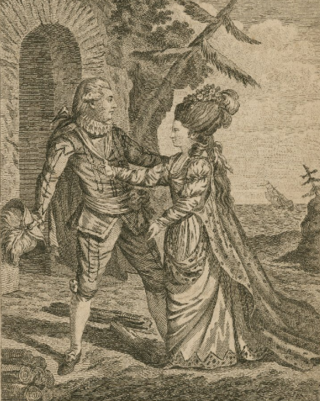Related Research Articles
Elizabeth Vincent was a British stage actress of the eighteenth century. She was the wife of the instrumentalist and composer, Richard Vincent.
Theophilus Keene (1680–1718) was an Anglo-Irish stage actor and theatre manager.
Henry Giffard was a British stage actor and theatre manager.
Anna Marcella Giffard (1707–1777) was an Irish stage actress.
Sarah Hamilton was an Irish stage actress and singer of the eighteenth century.
Thomas Hallam was a British stage actor.
John Sowdon was an Irish stage actor, singer and theater manager in the eighteenth century.
James Rosco was a British stage actor. His name is also written as James Roscoe.
Thomas Smith was a British stage actor of the eighteenth century.

George Mattocks (1735–1804) was a British stage actor and singer.
Thomas Griffith (1680-1744) was an Irish stage actor and theatre manager.
Richard Cross was a British stage actor of the seventeenth and eighteenth century.
Richard Cross was a British stage actor.
Luke Sparks (1711–1768) was an Irish stage actor of the eighteenth century.
Isaac Sparks (1719–1776) was an Irish stage actor.
Michael Atkins (1747-1812) was an English-born Irish actor and theatre manager. He has been described as "the single most important person in the early history of theatre in Belfast.
John Waddy (1751–1814) was an Irish stage actor and theatre manager. Originally, intended for a career in law, he was acting at Dublin's Smock Alley Theatre by 1774, combining this with appearances at Irish and English provincial theatres. From 1782 to 1796, he was a regular at the Theatre Royal, Norwich. He was then engaged by the Theatre Royal, Covent Garden in London making his debut there on 5 October 1796, under the management of Thomas Harris. He acted there and at Haymarket over the next decade and a half. He particularly specialised in playing Stage Irishman and also took over many roles when John Quick left Covent Garden. His second wife, billed as Mrs. Waddy, acted with him in London for several years. He departed from the Covent Garden company in 1810, and worked for a while at the Surrey Theatre south of the River Thames. He died in Oakingham in Berkshire on 12 April 1814.
Howard Usher was an English stage actor of the eighteenth century. He had a lengthy career in London's West End beginning at Drury Lane during the 1739–1740 season. A member of the company, he played smaller, supporting roles in a large number of productions. He also acted at the London fairs during the summer and at Richmond in Surrey and the Jacobs Well Theatre in Bristol. In 1750 he moved to Covent Garden for four years, before returning to Drury Lane for a further four years in 1758. He then moved to Ireland where he spent a number of years at the Smock Alley Theatre and Crow Street Theatre in Dublin and also appeared at the Theatre Royal, Cork. By this time he was married to the actress Maria Usher who appeared with him in Dublin. In 1774 he was recruited by David Garrick to return to Drury Lane. In 1778 he joined the company at the Theatre Royal, Haymarket and remained part of it for the next twenty one years. His final appearance was a reprise of his original role Sir Walter Manny in George Colman the Younger's The Surrender of Calais on 10 September 1799.
Elizabeth Hopkins (1731–1801) was an English stage actress of the eighteenth century. Born as Elizabeth Barton to a publican in York, she married the actor William Hopkins in 1753. and he introduced her to the stage. They acted together in the provinces and then in Edinburgh where she was original Anna in John Home's Douglas in 1756. She then went to Dublin to perform at the Smock Alley Theatre and elsewhere, although she was at one point dismissed by the company by Thomas Sheridan. When her husband was appointed as prompter at the Theatre Royal, Drury Lane in London she joined the company there, making her first appearance there in 1761. For several decades she was an integral part of the Drury Lane company, occasionally appearing elsewhere in the summer including at Richmond and the Theatre Royal, Haymarket. She transitioned in the 1780s from the younger, tragic roles she had played to older character parts such as dowagers Her final appearance was at the Haymarket in 1796. The actress Priscilla Kemble, wife of John Philip Kemble, was her daughter.
Thomas Robson (1737–1813) was a British stage actor and singer. Born as Thomas Robson Brownhill in Hull in 1737, he began his career in provincial theatre appearing in Norwich in the late 1760s. In 1769 he was at the Richmond Theatre and the following year made his London debut at the Theatre Royal, Haymarket then under the management of Samuel Foote. He originated roles of several of Foote's new farces, and also appeared the Orchard Street Theatre in Bath and the Smock Alley Theatre in Dublin over the next few years. In 1776 he joined the company of the Theatre Royal, Covent Garden and remained there until 1782, appearing in over a hundred roles. His last known roles in London were at the Haymarket in 1784.